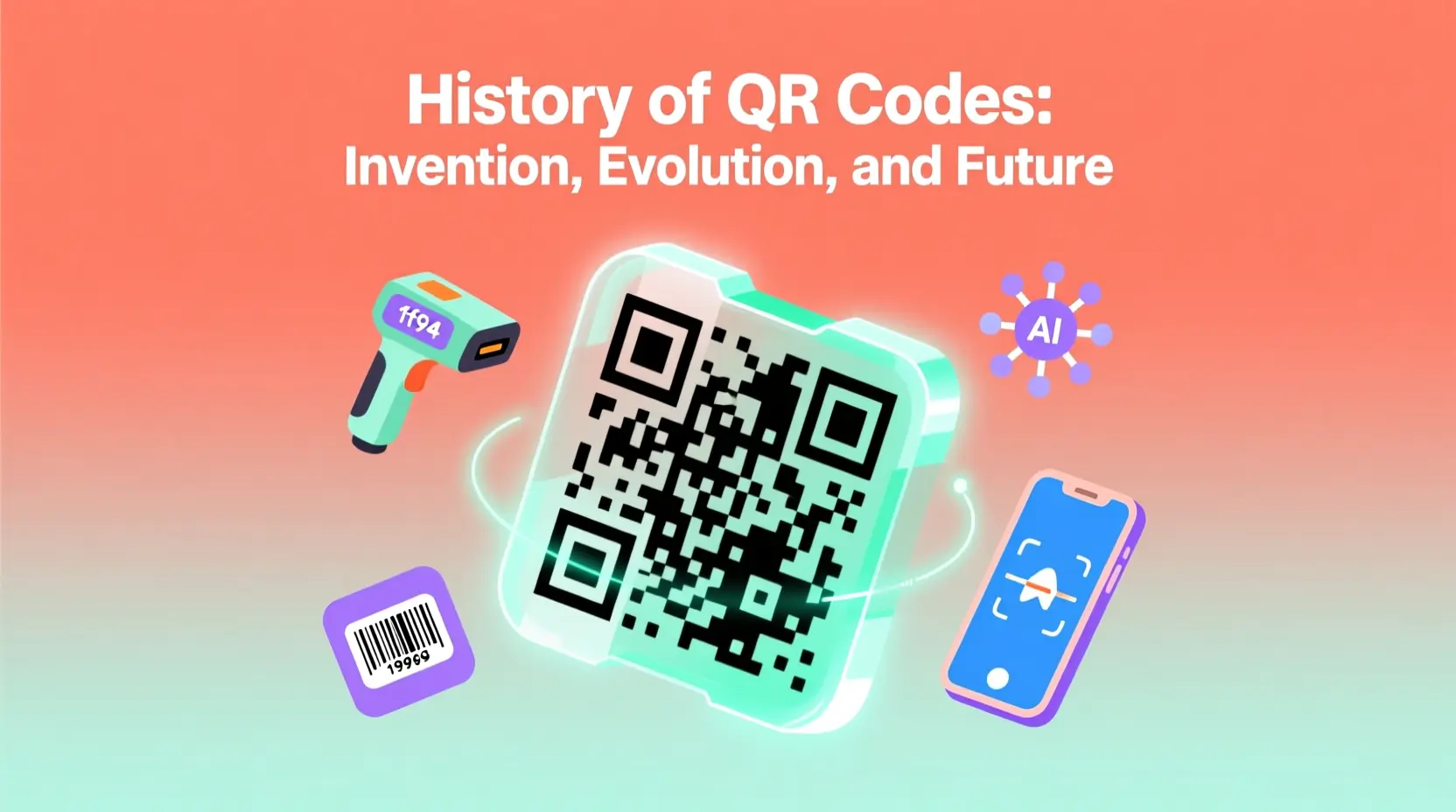History of QR Codes: Invention, Evolution, and Future
QR codes are everywhere today — on menus, business cards, packaging, and even tombstones. But their story begins not in Silicon Valley, but on the factory floor of a Japanese automotive giant — with a simple goal: track parts faster.
This is the true story of QR codes: how they were invented, how they evolved from industrial tool to global phenomenon, and why — in an age of AI and dynamic tracking — static QR codes remain the most reliable, private, and future-proof choice.
1994: The Birth of the QR Code (Toyota & Denso Wave)
In 1994, Japanese engineer Masahiro Hara and his team at Denso Wave (a subsidiary of Toyota) faced a problem: traditional barcodes couldn’t store enough data for Toyota’s just-in-time manufacturing system.
Barcodes held ~20 characters. They needed hundreds.
The solution? A two-dimensional matrix code — the Quick Response (QR) Code.
✅ Why “Quick Response”?
The square pattern allowed scanners to read it in any orientation — and up to 50× faster than linear barcodes.
✅ Open Standard from Day One
Crucially, Denso Wave never enforced its patent — making QR codes free for anyone to use. This decision fueled global adoption.
📜 Fun Fact: The three large squares in the corners? They’re “finder patterns” — inspired by the black-and-white pattern on a Go board (a traditional Japanese game Hara played).
🔗 Related: The Ultimate Guide to Static QR Codes
2000–2010: Quiet Growth — Then Explosion
For over a decade, QR codes remained niche — mostly used in logistics, automotive, and Japanese mobile phones (NTT Docomo’s “i-mode”).
Then came smartphones.
- 2005: Google launched Google Barcodes (later discontinued)
- 2008: Apple introduced App Store scanning via iTunes
- 2011: iOS 5 added native QR code support in the Camera app
Suddenly, anyone with a phone could scan — no app needed.
But a major problem emerged: broken links. Many early QR codes pointed to URLs that later changed or disappeared — rendering the code useless.
This is where the static vs. dynamic divide began.
🔗 Related: Static vs. Dynamic QR Codes
2020–2025: The Great QR Code Renaissance
The pandemic accelerated QR code adoption exponentially:
- 🍽️ Restaurants replaced paper menus with QR codes
- 🏥 Hospitals used them for contactless check-ins
- 🎫 Events shifted to digital ticketing
But users also grew wary:
- ❓ “Why does this QR code require an app?”
- 🔍 “Is it tracking me?”
- 🚫 “It worked last month — why not now?”
These concerns highlighted the weaknesses of dynamic QR services (third-party servers, tracking, subscription fees) — and renewed appreciation for static QR codes:
- ✅ Work forever — data is embedded
- ✅ No tracking — 100% private
- ✅ Free — no monthly fees
- ✅ Work offline
📊 A 2024 Pew Research study found that 73% of users prefer QR codes that don’t require app downloads or logins — precisely what static QR codes deliver.
🔗 Related: Why You Should Use Static QR Codes for Business
The Future: AI, AR, and Beyond — Without Sacrificing Privacy
Where are QR codes headed?
🔮 Near Future (2025–2027)
- AI-Powered Scannability: Tools like QRCodeAI use client-side AI to predict scanning success — before you print — using contrast, logo placement, and error correction modeling.
- Standardized Semantic QR: Codes that encode structured data (e.g., “Event: Name, Time, Location”) — enabling richer native actions across devices.
🌐 Long-Term Vision
- QR + AR Integration: Scan a code → unlock 3D model or spatial experience (already in use at museums and retail).
- Blockchain IDs: Immutable QR-linked credentials (e.g., diplomas, certifications) — verifiable, tamper-proof, and user-owned.
But here’s the critical insight:
The most advanced future still depends on the most fundamental principle: reliability.
And nothing is more reliable than a static QR code — where the data lives in the code itself, not on a server that may vanish.
🔗 Related: How the AI-Powered Scannability Analysis Works
Why Denso Wave’s Original Vision Still Matters
Masahiro Hara designed QR codes to be:
- ✅ Open (no patents enforced)
- ✅ Robust (error correction up to 30% damage)
- ✅ Universal (standardized, device-agnostic)
Today, static QR codes honor that vision.
They don’t chase analytics or lock users into platforms. They just work — instantly, privately, and forever.
In a world of fleeting tech trends, that kind of simplicity is revolutionary.
Final Thought
QR codes are over 30 years old — yet more relevant than ever.
Their power doesn’t come from complexity, but from elegance: a square of dots that bridges physical and digital — with no middleman.
And as long as there are scanners, your static QR code will keep delivering — exactly as intended.
✅ Ready to Create a QR Code That Will Work — Today, Tomorrow, and in 2050?
👉 Generate Your Free, Static QR Code Now — 100% Private, No Sign-Up
- ✅ Based on the original, open QR standard
- ✅ AI-powered scannability analysis
- ✅ Customize with your brand (
#ff6f48included!) - ✅ Download as PNG or SVG — for print or web
Honor the past. Design for the future.
📌 Explore more:

